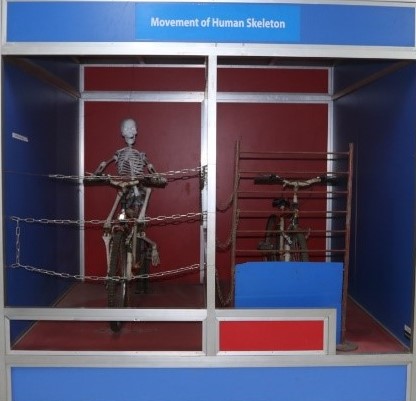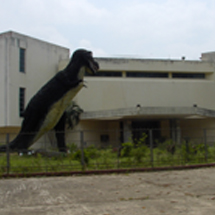সর্ব-শেষ হাল-নাগাদ: ১৪ মে ২০২২
সাইকেলের উপর মানব কঙ্কলের অঙ্গ/পা সঞ্চালন

প্রদর্শনীটিতে একটি ধাতব (ডুরালুমিন নির্মিত) মানব কঙ্কাল মঞ্চে রক্ষিত সাইকেলের উপর রাখা আছে। অপর পার্শ্বে মঞ্চে দ্বিতীয় একটি সাইকেলে কোন দর্শক চড়ে সাইকেলের প্যাডেলে চাপ দিলেই কঙ্কালটিও তার সাইকেলে প্যাডেল চালাতে শুরু করে। এর দ্বারা মানবদেহের ভিতরের কঙ্কালের পা কিভাবে সঞ্চালন করে তা অনুমান করা যায়।
কারণ:
দুটি সাইকেলেই পেছনের চাকা যান্ত্রিকভাবে মঞ্চের নিচে সংযুক্ত আছে। উভয় সাইকেলের পেছনের চাকার হুইলদ্বয় দুটি পৃথক চেইন দ্বারা মঞ্চের নীচে স্থাপিত একটি শেইপের সাথে দুই প্রান্ত সংযুক্ত খাকে। ফলে মাবচালিত সাইকেলে প্যাডেল দিলেই কঙ্কালচালিত সাইকেলটিরও পেছনের চাকা ও হুইল ঘুরতে থাকে। ফলে আপাতদৃষ্টিতে মনে হবে যে কঙ্কালটিও সাইকেল চালাচ্ছে।
The exhibition features a metal (made of duralumin) human skeleton placed on a bicycle preserved on the stage. On the other side of the stage, as soon as a spectator rides on a second bicycle and presses on the pedal of the bicycle, the skeleton also starts pedaling on his bicycle. This gives an idea of how the skeletal legs move inside the human body.
Reason:
The rear wheels of both bicycles are mechanically attached to the bottom of the stage. The rear wheel wheels of both the bikes have two separate chains connecting the two ends with a shape placed at the bottom of the platform. As a result, the rear wheels and wheels of the skeleton-powered bicycle keep turning as soon as you pedal it. As a result, it would seem that the skeleton is also cycling.
সর্বশেষ খবর
পবিত্র রমজান মাস উপলক্ষ্যে শনি থেকে বুধবার সকাল ৯.০০টা থেকে বেলা ৩.৩০টা পর্যন্ত জাদুঘরের গ্যালারী খোলা থাকবে। বৃহস্পতি ও শুক্রবার সকল ধরণের প্রদর্শনী বন্ধ থাকবে। এছাড়া রমজান মাসে টেলিস্কোপ প্রদর্শনী বন্ধ থাকবে।
Array
(
[id] => 7940452d-2f6d-4e42-8f87-8afb3227ed08
[version] => 63
[active] => 1
[publish] => 1
[created] => 2015-01-25 15:58:17
[lastmodified] => 2024-11-03 13:26:54
[createdby] => 136
[lastmodifiedby] => 2598
[domain_id] => 6414
[office_id] =>
[menu_id] =>
[title_bn] => মহাপরিচালক
[title_en] => Director General
[body_bn] =>
[body_en] =>
[userpermissionsids] =>
[uploadpath] => e9005938-c62a-4cda-bdf2-fb21556182fc
[userip] => 127.0.0.1
[useragent] => Mozilla/5.0 (Windows NT 10.0; Win64; x64) AppleWebKit/537.36 (KHTML, like Gecko) Chrome/130.0.0.0 Safari/537.36
[usergeo] =>
[is_right_side_bar] => 1
[office_head_photo] => Array
(
[0] => Array
(
[name] => 2024-11-03-07-22-6b2a72f3355ff271bf2bf600fddeeab8.jpg
[caption_bn] => মহাপরিচালক
[caption_en] => Director General
[link] =>
)
)
[office_head_description] => মহাপরিচালক
[office_head_des_bn] => মুনীরা সুলতানা এনডিসি
মুনীরা সুলতানা এনডিসি, অনানুষ্ঠানিক বিজ্ঞান শিক্ষা কার্যক্রমের মাধ্যমে একটি বিজ্ঞানমনস্ক জাতি গঠনের লক্ষে ৩১ অক্টোবর, ২০২৪খ্রিঃ তারিখে জাতীয় বিজ্ঞান ও প্রযুক্তি জাদুঘরের মহাপরিচালক হিসেবে দায়িত্ব গ্রহণ করেন।
তিনি ১৯৯৩ সালে বাংলাদেশ সিভিল সার্ভিস প্রশাসন ক্যাডারে যোগদানের মধ্য দিয়ে কর্মজীবন শুরু করেন। তিনি বেশিরভাগ সময় বিভিন্ন মন্ত্রণালয় ও অধিদপ্তরে এবং মাঠ প্রশাসনে দায়িত্ব পালন করেন। ঢাকা বিশ্ববিদ্যালয় থেকে উদ্ভিদবিদ্যা বিভাগ থেকে তিনি স্নাতকোত্তর ডিগ্রি অর্জন করেন। চাকরিতে কর্মরত অবস্থায় তিনি নর্দান ইউনিভার্সিটি, ঢাকা থেকে গভর্নেন্স স্টাডিজ বিষয়ে দ্বিতীয় স্নাতকোত্তর ডিগ্রি অর্জন করেন। তিনি ২০১৮ সালে ন্যাশনাল ডিফেন্স কলেজ থেকে ন্যাশনাল ডিফেন্স কোর্স সাফল্যের সাথে সম্পন্ন করেন।
চাকুরিরত অবস্থায় তিনি দেশে এবং বিদেশে বিভিন্ন পেশাগত প্রশিক্ষণ কোর্স সাফল্যের সাথে সম্পন্ন করেন। একটি বিজ্ঞানমনস্ক জাতি গঠনে এবং সারা দেশে বিজ্ঞান ও প্রযুক্তির সুফল ছড়িয়ে দিতে তিনি নিরলস কাজ করে যাচ্ছেন।
[office_head_des_en] => Munira Sultana ndc
Munira Sultana ndc, took charge as Director General of National Museum of Science and Technology on October 31, 2024 with the aim of building a science minded nation through informal science education programs.
She started her carrier in the Bangladesh Civil Service administration cadre in 1993. She served mostly in field administration and different ministries and directorate. She earned her degree of M.Sc. in Botany from the University of Dhaka. While in service, she earned a second Masters degree in Governance Studies from the Northern University, Dhaka. She completed the National Defense Course successfully in 2018 from National Defense College.
She acquired various professional training courses during her service period in home and abroad and keenly interested in building a science minded nation and spread the blessings of Science and Technology across the country.
[designation] =>
[designation_new_bn] => মহাপরিচালক
[designation_new_en] => Director General
[weight] => 0
)
=======================
কেন্দ্রীয় ই-সেবা
পথ নির্দেশিকা

হটলাইন

সামাজিক যোগাযোগ

জরুরি হেল্পলাইন নম্বর




.jpg)













